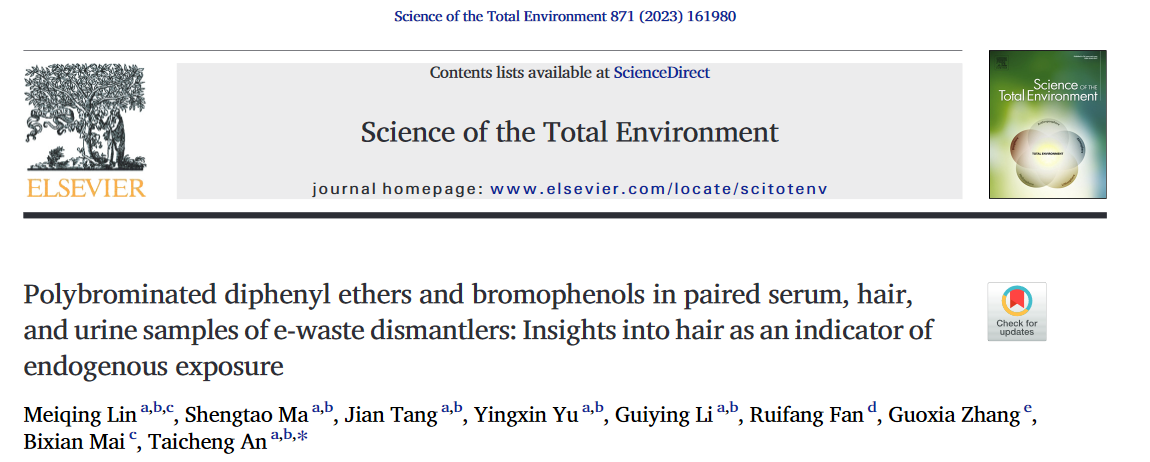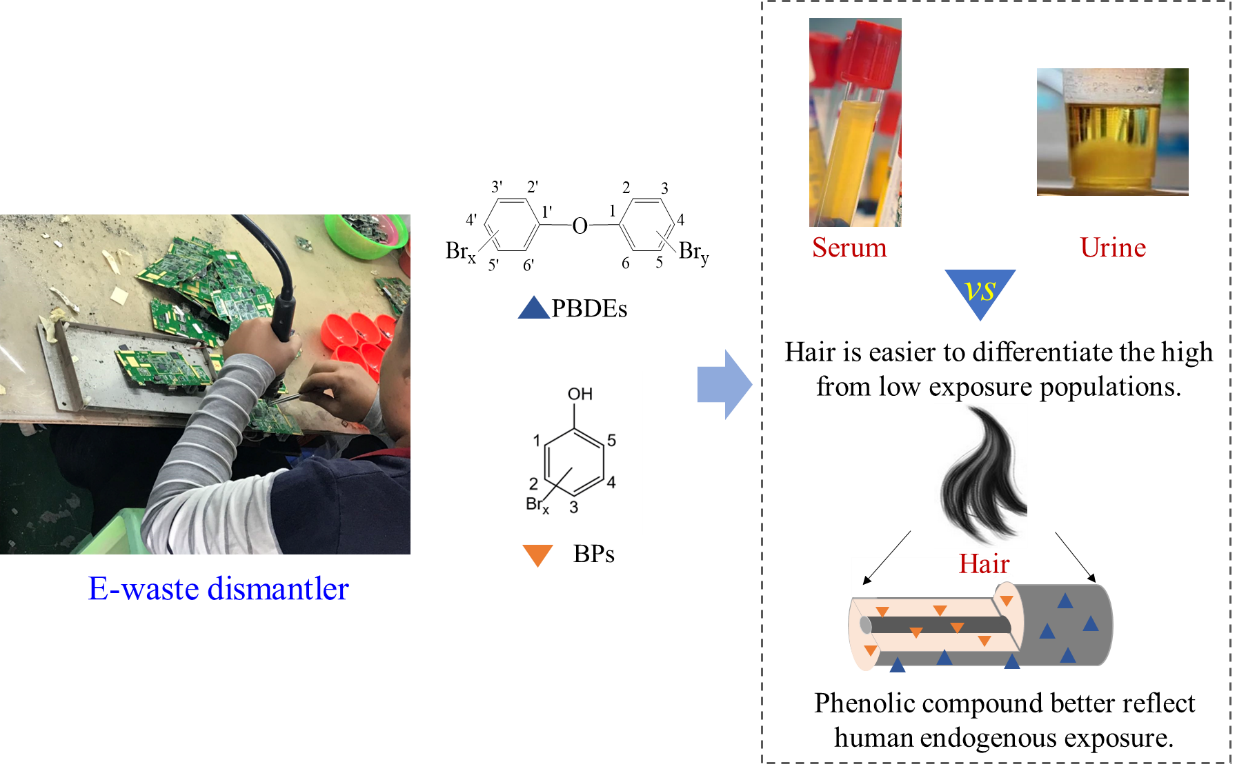近日,广东工业大学环境健康与污染控制研究院、环境科学与工程学院安太成教授团队在电子垃圾拆解区人群配对血清、头发和尿液样本中多溴联苯醚和溴酚的分布特征方面取得最新研究进展,研究成果以《Polybrominated diphenyl ethers and bromophenols in paired serum, hair, and urine samples of e-waste dismantlers: Insights into hair as an indicator of endogenous exposure》为题发表在Science of The Total Environment (2023, 870: 161980)期刊上。论文的第一作者为博士后林美卿,通讯作者为安太成教授。该工作报道了多溴联苯醚(PBDEs)和溴酚(BPs)在电子垃圾拆解职业暴露人群和非职业暴露人群中配对血清、头发和尿液样本中的浓度和分布特征,并通过动物实验探讨了毛发中PBDEs和BPs的来源。相关研究结果为头发作为PBDEs和BPs的人体暴露监测检材提供了新见解。

论文的网址:
https://doi.org/10.1016/j.scitotenv.2023.161980
多溴联苯醚(PBDEs)由于其大量生产和使用,是我国电子垃圾拆解过程中的重要污染物。溴酚(BPs)既是一种阻燃剂也是PBDE的二苯醚键裂解代谢产物,在人体暴露评估中常被忽视。本研究以来自电子垃圾拆解园区内的电子垃圾拆解工人、非电子垃圾拆解工人和园区外的成年居民和儿童居民为研究对象,采集他们配对的血清、头发和尿液样本,测定了22种PBDEs和19种BPs的浓度水平。发现与血清和尿液样本相比,在头发中可以检测到更多的目标化合物。职业人群头发内源ΣPBDEs和ΣBPs的浓度中值分别为350和547 ng/g dw,显著高于非职业人群。但职业人群与非职业人群血清和尿液中ΣPBDEs和ΣBPs的浓度并无显著性差异。这表明:与血清和尿液分析相比,头发分析更容易区分这两类物质的高暴露人群和低暴露人群。此外,头发内源中BPs的含量比头发外源高1–2个数量级,而PBDEs在头发内外源中的含量差异不显著。这表明BP可能主要来自内源贡献。值得注意的是,作为PBDE和BP的主要同系物,头发内源2,4,6-TBP含量比BDE-209高3–8倍,而头发外源中2,4,6-TBP含量却比BDE-209低1–3倍。通过在SD大鼠分别口服BDE-209和2,4,6-TBP暴露28天后的实验进一步表明: 2,4,6-TBP在毛发中的内源性积累可归因于BDE-209代谢和2,4,6-TBP的内暴露。综上所述,我们的结论就是与原型PBDEs相比,用毛发监测酚类化合物或代谢物能更好地反映人体中化合物的内暴露水平。
图文摘要:

英文摘要:
Polybrominated diphenyl ethers (PBDEs) are important pollutants during electronic waste (e-waste) dismantling activities in China due to its large quantities production and usage. Bromophenols (BPs), which are a kind of flame retardants and the diphenyl ether bond cleavage metabolites of PBDE, are often neglected in the human exposure assessment. In this study, 22 PBDEs and 19 BPs were determined in paired serum, hair, and urine samples collected from workers and residents of a typical e-waste dismantling site in Southern China. PBDE and BP congeners were more frequently detected in hair than serum and urine samples. The medians of ΣPBDEs and ΣBPs were 350 ng/g dw and 547 ng/g dw in hair internal (hair-In) of occupational population, respectively, which were significantly higher than non-occupational population. However, a non-significant difference was found in levels of ΣPBDEs and ΣBPs in serum and urine between occupational and non-occupational population. It suggests hair analysis could be easier to differentiate the high from low PBDEs and BPs exposure populations than serum and urine analysis. Moreover, the levels of BPs in hair-In were 1–2 orders of magnitudes higher than those in hair external (hair-Ex), while a non-significant difference was found in the levels of PBDEs. This indicates BPs might be mainly derived from the endogenous contribution. Notably, as the predominant congeners, the level of 2,4,6-Tribromophenol (2,4,6-TBP) in hair-In was 3–8 times higher than those of BDE-209, while the level of 2,4,6-TBP in hair-Ex was 1–3 times lower than those of BDE-209. Further in vivo experiment performed on Sprague–Dawley rats following a 28-day oral treatment with BDE-209 and 2,4,6-TBP verified that endogenous accumulation of 2,4,6-TBP in hair could be attributed to BDE-209 metabolizing and 2,4,6-TBP exposure. In conclusion, compared to PBDEs, biomonitoring phenolic compound or metabolite with hair could better reflect human endogenous exposure.